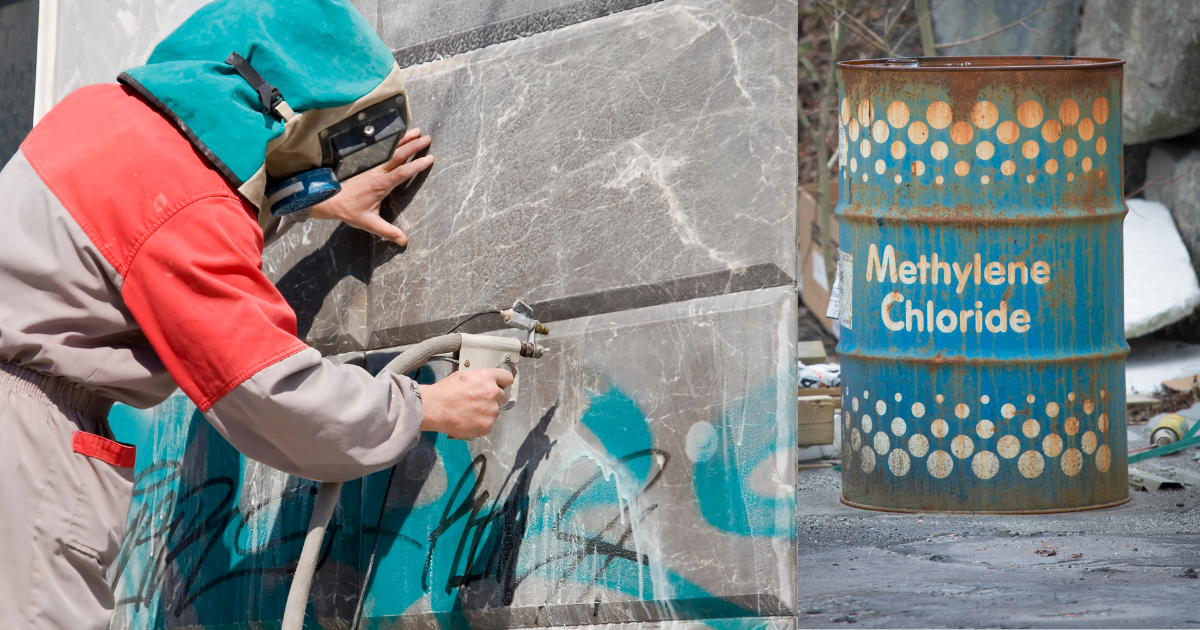Update July 25, 2023: The U.S. EPA has received tens of thousands of comments on its proposal to ban all consumer and many commercial uses of this highly dangerous toxic chemical, methylene chloride. We are glad that thousands of those comments came from supporters of Toxic-Free Future and allies like Public Citizen, Clean Water Action, Moms Clean Air Force, and Vermont PIRG.
To read more about the proposal, please read this story of the families who lost loved ones to the deadly effects of methylene chloride exposures. Their activism to prevent other families from having the terrible experience they have had is inspiring.
EPA will now review the comments and is expected to release a final rule next year. Toxic-Free Future will continue to advocate for rule.
We’ve waited long enough. To protect workers and communities, EPA should quickly finalize a methylene chloride rule that bans most, if not all, uses of this dangerous chemical.
Methylene chloride exposure has been linked to the deaths of dozens of consumers and workers since the 1980s. This chemical used in paint strippers and other products can cause immediate death by asphyxiation and heart attack, and has been linked to cancer and cognitive impairment.
EPA’s announcement last week that it will ban most uses of methylene chloride gives us hope that no one else will die because of this deadly chemical.
What will the proposed rule do?
The proposed rule will ban all consumer uses and most industrial and commercial uses of the chemical, including degreasers, spot removers, and paint or coating removers, among others.
It also includes workplace protection requirements for time-limited critical use exemptions and notable exemptions for Department of Defense, FAA, Department of Homeland Security and NASA. For the exemptions, EPA has proposed “workplace chemical protection program(s) with strict exposure limits to better protect workers.”
But these exemptions could leave some workers with less protection for a decade. That said, this rule takes a highly toxic chemical off store shelves and out of most workplaces.
It is not a small thing to say that the rule’s prohibitions on uses of methylene chloride certainly would not have happened under the 1976 Toxic Substances Control Act (TSCA) that our coalition worked for years to reform.
The pace of federal action on toxics remains unacceptably slow. And it didn’t help that EPA’s leadership took an anti-regulatory posture in January 2017 just as TSCA reforms began to take effect. So here we are — nearly seven years since the reformed statute was signed, and this is only the second action on an “existing” chemical that EPA has proposed under its authority.
A brief history of toxic methylene chloride
This is important progress that will protect public health from toxic chemicals. The timeline of action leading up to this day shows the many years of critical work that it took to get to this point.
It was not surprising to find methylene chloride on EPA’s list of the “first ten” chemicals to be evaluated and managed under reformed TSCA. Three deaths were associated with acute exposure to the chemical in 1976, with calls for EPA to ban its use in paint strippers.
EPA certainly had substantial evidence of the chemical’s dangers long before 2016 — indeed, the available facts led then-Administrator Gina McCarthy to use EPA’s authority under reformed TSCA to propose banning paint and coating removers with methylene chloride for both consumer and workplace uses in late 2016.
Our activists and coalition partners were more than happy to contribute many of the tens of thousands of comments that EPA received in support of the bans. State partners gladly joined our campaign to persuade retailers like Lowe’s and The Home Depot to stop selling such products even before the ban was final.
Unfortunately, the Scott Pruitt-led EPA put both rules into a drawer and slowed action on the broader chemical evaluation.
Justifiably angered by EPA’s inaction, families of young people who died using such products came to DC and met with EPA staff and members of Congress, putting a human face on the real dangers of methylene chloride. Some of them joined us and our coalition partners in suing the EPA to demand greater protections.
In 2019, when EPA Administrator Andrew Wheeler announced a ban on sales to consumers, we pointed out that, while welcome, the action still left workers in harm’s way.
We were joined by mothers of two of the young people who had died and our partners at Vermont PIRG in filing suit in federal court to compel the same protections for workers as EPA had granted consumers. (Because our suit was not the only one, the court combined it with petitions from NRDC, Labor Council for Latin American Advancement, and the Halogenated Solvent Industry Association. The latter was arguing that EPA should not have banned consumer uses). While glad that the judge rejected the industry trade group’s bid to roll back the consumer rule, we were profoundly disappointed that the Court declined in 2021 to require EPA to ban commercial uses, leaving workers exposed to this dangerous chemical.
As EPA continued its risk evaluation of methylene chloride, we continued to push for protections from all uses of the chemical. It was somewhat heartening when EPA issued a risk evaluation in 2020 determining “unreasonable risk” from 47 out of 53 uses. It was more encouraging when the new administration re-did the evaluation, recognizing that personal protective equipment should not be assumed to protect workers, and found all but one of the 53 uses it reviewed to pose unreasonable risks.
We met multiple times with the EPA and White House staff who developed the risk evaluation and the resulting rule, providing important testimony to the EPA Science Advisory Committees and telling the stories of the people who could not be there.
EPA: It’s time to finish the job!
We’re not done yet – once the rule is published in the Federal Register, there will be a 60-day comment period, followed by an alphabet soup of federal agencies reviewing the comments before it becomes final.
We’re calling on the EPA to finish the job by quickly issuing a strong rule that protects all workers, consumers, and communities. Please make your voice heard during the comment period via our online petition. To learn more, visit our methylene chloride priority page.





